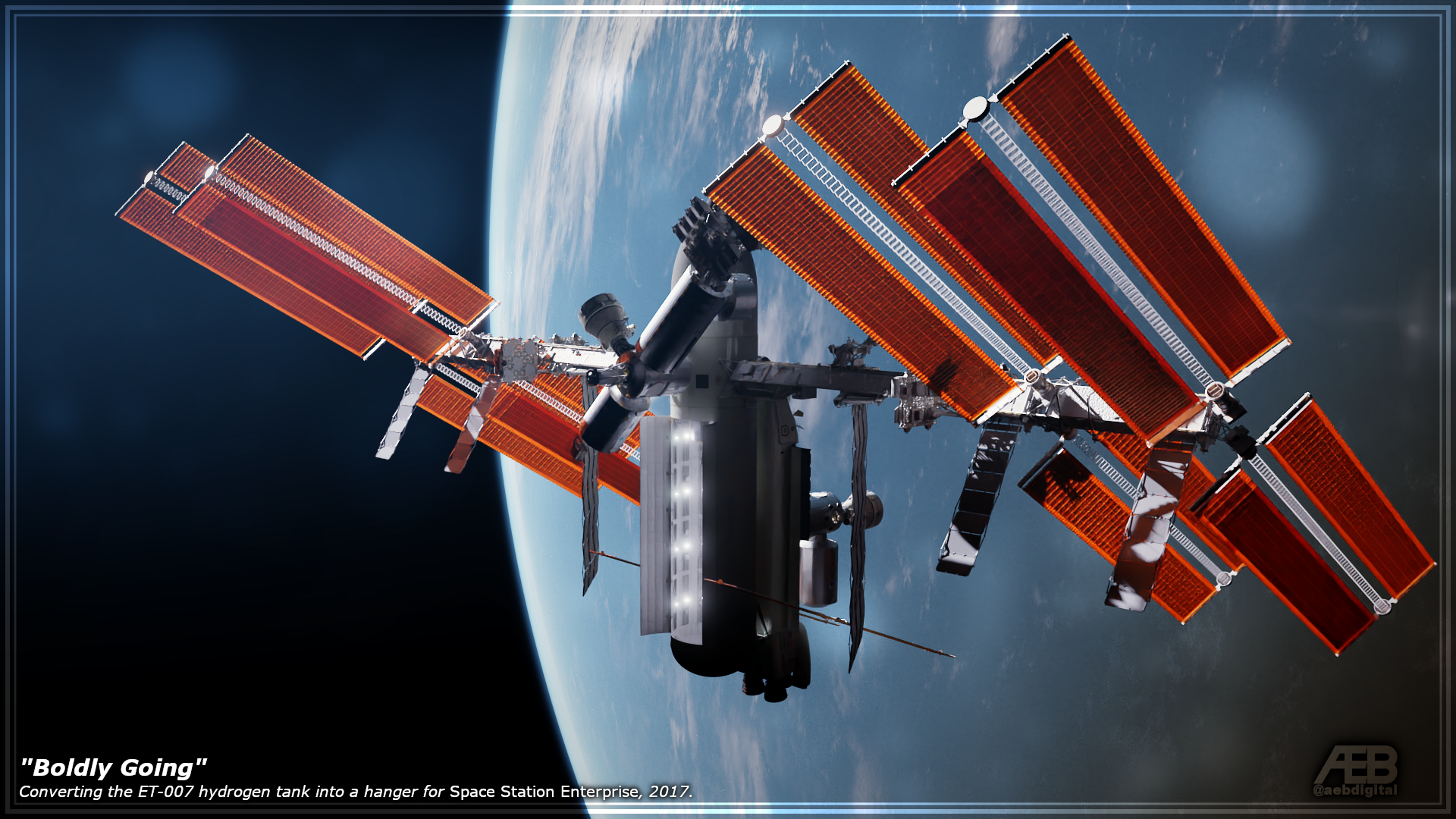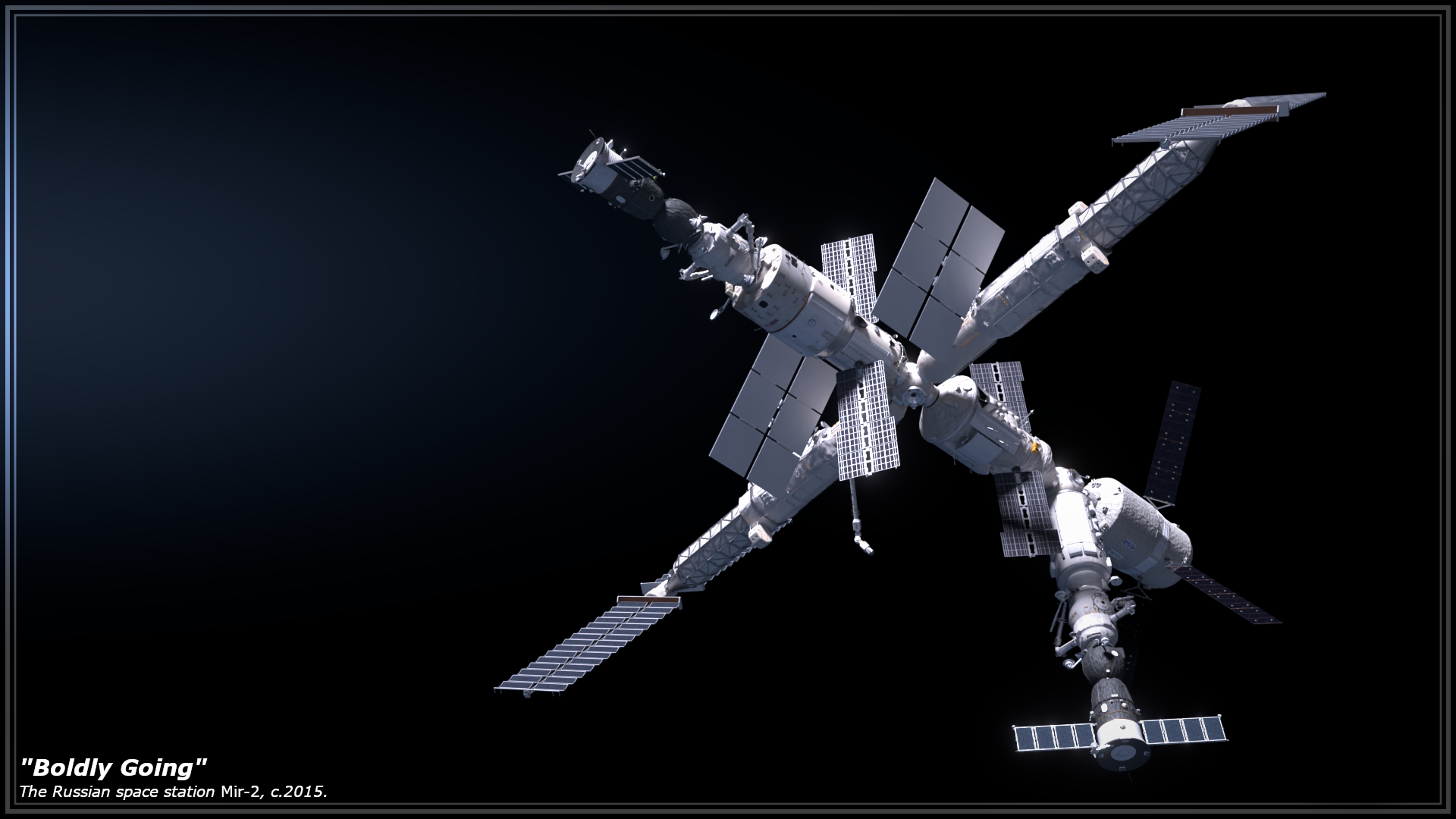Boldly Going Part 31
Space Station Enterprise’s augmented crews began the work of assembling the new hangar bay fixtures inside the liquid hydrogen tank in 2015. Despite the benefits of working entirely in IVA, crews aboard
Enterprise still found the process of welding fixtures to the tank walls in zero gravity challenging. While welding trials had been carried out experimentally, never before had welding been carried out in space on such a scale with intent to use the results. Mounting points for power and data cable runs were relatively simple to position with fixtures that mounted over the stringers and ring frames of the tank. A larger challenge came from the internal rail system which would allow a new miniature robotic arm inside the bay to function as a kind of “bridge crane,” similar to the Mobile Base Systems on the port and starboard trusses for CanadArm2. The waffle-grid pattern of stringers on the interior of the tank had been carefully machined for supporting the tank during launch. Now, the new rail mounts could take advantage of their tight tolerances to provide a pre-aligned base for the new system, but care still had to be taken as the crew members clamped the new mounts in place, aligned the rail, and welded it into final position. Over a year and a half, tasks were checked off the “to-do list” regularly, but there was always more to do.
By 2017, the rail and the mobile robotic arm base for the new “crane” had been installed and tested. Other preparations included installing similarly-precise payload mounting trunnions and stringing nearly a quarter mile of power and data cables. New flood lighting was added to illuminate the bay, and then nearly a quarter acre of fabric panels were added to line the bay, both to protect the wiring and to mitigate reflections from the original metal interior skin.[1] Finally, the rough preparations for cutting the new hangar’s door had been completed, minimizing work which would have to be carried out in vacuum. The hinge and actuator mechanisms for the doors were pre-installed and checked in shirtsleeve IVA, allowing the hinges to be “pre-aligned.” Once the marked section of the tank wall was cut, only minimal EVA work would be required to turn the remnant into a functional door though it would never work as a pressurized hatch. All that remained before the irreversible cutting of the bay door was the final installation of the new internal docking ring.
As anticipated, the ring’s installation and sealing proved troublesome. Several days of IVA work was spent on aligning the installation and tack welding the new ring components into place. From there, the secondary sealing gaskets could be tested, before being doubled up with the final welding of the two-piece docking ring into a single component welded in turn to the tank wall. Multiple attempts at this critical joining operation were required before the new internal docking ring was able to pass leak tests at the three times overpressure required by ground engineers and spaceborn astronauts alike. A leak in this area, so close to the station’s hamster tubes, could be insidious and tremendously risky. The crew of
Enterprise were willing to do the job several times over if so required to ensure an issue never occurred. Because of the time required for its installation and the cost of an astronaut’s labor per hour on station, the new 300 kg docking structure was calculated as one of the most expensive construction operations in human history in terms of cost-per-kilogram. Eventually, though, the task was complete.
When the time came to cut open the 70-foot long “bomb bay” style door in the hangar’s 96-foot long sidewall, crews vacated the bay and left the task to a cutter attached to the station’s robotic arm. Cutting through the sidewall not only simplified the cuts compared to trying to cut off the end-dome of the tank, but also allowed a larger door for access to the bay and avoided interference with the “U”-shaped sump still in place in the LH₂ aft dome. This sump, and its associated plumbing and baffles, had drawn the hydrogen for
Enterprise’s thirsty engines on their first and only climb to obit more than twenty years before, then had been plugged to seal the bay on STS-38R. The complexity of cleanly cutting the massive pipe was better avoided in NASA’s opinion. With the bay door cut and its edges cleared of burrs, the new hangar bay was open for business. The next Shuttle to arrive at the station carried up the new Hangar Control Module, the last major pressurized addition to the station to date. Installation in the confined hangar was eased by using the hangar’s own robotic crane arm for final alignment and installation. Once the module was attached and activated,
Enterprise finally had a fully functional robotics control station with a view on the other side of the station than the OV-101 control deck as well as a fully redundant (and much improved) primary personnel airlock. The doors, for their part, functioned as expected. While they could not seal the bay, they were sufficient to close off paths into it for most debris and radiation. Perhaps even better, they were sufficient to prevent tools or equipment from being lost on EVA within the bay, the end to a long-standing problem.
When
Galileo ferried Hubble to the station for their next overhauls in 2018, the benefits were demonstrated beyond argument. The repair scope for Hubble was particularly extensive: new solar arrays designed for repeated extension and retraction to fit in the new
Enterprise hangar, two of the telescope’s gyroscopes replaced, the swapping of a star-tracker (never originally intended for replacement in orbit), as well as the replacement of one of the primary cameras with the latest in a series of progressively upgraded units. Even before the hangar’s introduction, Hubble servicing aboard
Enterprise was preferred to servicing with Shuttle, as EVA tasks could be spread over more days without a return to Earth driving the schedule. In this case, however, the task list was accomplished with ten percent fewer EVA hours than predicted based on past
Enterprise overhauls of
Hubble. Astronauts ran hours ahead on every EVA thanks to improved coordination with robotics operators, consistent controlled lighting, and reduced time from the airlock to the worksite. With the overhaul of Hubble completed days early, the main challenge of the vehicle’s visit to station was a renewed debate between ESA astronauts and NASA crew if pulling
Galileo into
Enterprise’s hangar for inspection of its OMS engines rendered it a “shuttle” based from Enterprise’s hangar, instead of a free-flying station.[2]
In the meantime, the original Space Shuttle program had wound its way towards conclusion. The first-generation reusable vehicle which had spawned and nurtured
Enterprise was due for replacement by a next-generation fleet of spacecraft. The new Shuttle-II and reusable Conestoga vehicles were hoped to operate surface-to-orbit and orbit-to-the-moon for a fraction of the cost. The remaining four original series orbiters,
Atlantis,
Columbia,
Challenger, and
Endeavour, had all done their part in shaping the history of space development. Their constant support carrying the flag of
Space Station Enterprise to and from the launch pad for almost thirty years played no small part in the station’s success. However, with Shuttle-II on the horizon, the program was already looking to the next generation. As the finale of the original Space Shuttle neared, carrying the flag of supporting
Space Station Enterprise and the next generation of lunar and Mars exploration would fall to Atlas III, Shuttle-C, and Shuttle-II...if the agency could navigate a critical series of technical and funding challenges.


Artwork by:
@nixonshead (
AEB Digital on Twitter)
[1] This fabric liner, on the vast interior surface of the tank-turned-hanger, had a number of features of note, including the Station’s name, a NASA Meatball, and in one area, tributes to the many seamstresses who had worked in aerospace ranging from Ida Holdgreve (
about whom the Smithsonian Magazine has recently run an article - and she had an absolutely fascinating story) who worked for the Wright brothers, through those who had sewn the Apollo Lunar suits, to the teams that had made the liner itself.
[2] Stories of efforts to get an “OV-101 ⁄ 7
Galileo” decal on the side of the ESA vehicle are purely apocryphal.


